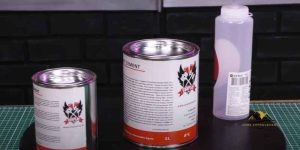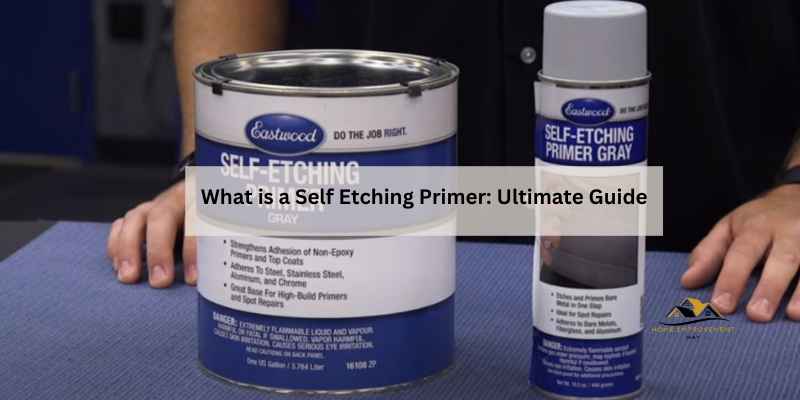A self-etching primer is a rust preventive coating that etches and primes in one coat. It is designed to create a bond between the metal surface and the subsequent layers of paint or coating, providing enhanced adhesion and corrosion resistance.
Self-etching primers are typically used on new or relatively sound ferrous and non-ferrous metal surfaces, such as lightweight tubing or thin sheet metal, where abrasive blast cleaning is not feasible. The primer contains acid additives that microscopically react with the substrate, creating a microscopic profile for improved bonding.
By understanding the purpose and application of self-etching primers, you can effectively prepare metal surfaces for optimal paint adhesion and long-lasting protection against rust and corrosion.
Types Of Self Etching Primers
When it comes to priming surfaces, self etching primers play a crucial role in ensuring proper adhesion and protection. There are different types of self etching primers available, each with its unique characteristics and applications.
Acid-based Self Etching Primers
An acid-based self etching primer contains acid additives that react with the metal substrate, creating a strong bond. This type of primer is ideal for bare metal surfaces and provides excellent corrosion resistance.
Zinc-based Self Etching Primers
Zinc-based self etching primers use zinc particles to provide enhanced adhesion and protection against rust and corrosion. These primers are suitable for surfaces exposed to harsh environmental conditions.
Applications Of Self Etching Primers
Self etching primers are versatile coatings that are specifically designed to promote adhesion and corrosion resistance on various metal surfaces. They are commonly used in automotive, industrial, and marine applications due to their ability to enhance the durability and longevity of metal substrates. These primers are formulated to provide excellent bonding characteristics, making them suitable for use on both ferrous and non-ferrous metals.
On Ferrous Metals
Self etching primers are particularly effective when applied to ferrous metals such as steel and iron. These metals are prone to rust and corrosion, and the application of a self etching primer creates a protective barrier that helps prevent the onset of corrosion. The primer chemically bonds to the metal surface, ensuring superior adhesion of subsequent paint or topcoat layers. This makes it an ideal choice for automotive body panels, chassis components, and other steel structures.
On Non-ferrous Metals
When it comes to non-ferrous metals like aluminum, copper, and brass, self etching primers play a crucial role in improving paint adhesion and corrosion resistance. These metals are inherently resistant to rust, but they still require a proper bonding agent to ensure long-lasting paint finishes. Self etching primers create a microscopically etched surface on non-ferrous metals, enabling the paint to adhere firmly and providing an additional layer of protection against environmental elements.
How To Use Self Etching Primer
A self etching primer is a type of primer that is designed to be used on metals that cannot be prepared by abrasive blasting. These primers contain acid additives that react with the metal surface, creating a microscopic profile that allows the primer to bond to the surface. This makes them an excellent choice for use on new or relatively sound ferrous and non-ferrous metal surfaces.
Surface Preparation
Before applying a self etching primer, it is important to prepare the surface properly. Start by cleaning the surface with grease and wax remover to remove any contaminants that could affect the adhesion of the primer. Next, use a fine-grit sandpaper or abrasive pad to scuff the surface and create a good surface profile for the primer to adhere to.
Application Techniques
When applying self etching primer, it is important to use proper application techniques to ensure a smooth and even finish. Start by shaking the can well before use and test the spray on a small inconspicuous area to ensure proper adhesion. Hold the can approximately 8-10 inches away from the surface and use a sweeping motion to apply the primer in light, even coats. Avoid heavy build-up or runs by using multiple light coats, allowing each coat to dry before applying the next.
It is also important to apply the primer in a well-ventilated area and wear appropriate personal protective equipment, such as gloves, safety glasses, and a respirator mask.
Once the primer has been applied, allow it to dry for the recommended time before applying any topcoat or sealer. This will ensure proper adhesion and a smooth, even finish.
Conclusion
Using a self etching primer is an excellent way to ensure proper adhesion and a long-lasting finish on metal surfaces. By following proper surface preparation and application techniques, you can achieve a smooth and even finish that will protect your metal surfaces for years to come.
Differences Between Self Etching Primer And Regular Primer
Chemical Composition
Self-etching primer contains acidic components that create a microscopic profile on the substrate, promoting adhesion. Regular primer, on the other hand, does not have these acidic additives and relies on mechanical bonding.
Adhesion Properties
Self-etching primers are specifically designed to adhere to bare metal surfaces, creating a strong bond. Regular primers may not provide the same level of adhesion to metal substrates, especially on surfaces that have not been thoroughly cleaned and prepared.
When To Use Self Etching Primer
Self etching primer is used on new or sound metal surfaces like lightweight tubing or thin sheet metal that can’t be prepared by abrasive blast cleaning. It features acid additives that create a microscopic profile for better adhesion, making it ideal for galvanized metal.
This primer is essential for ensuring a durable and long-lasting paint job.
On New Metal Surfaces
Self Etching Primer is ideal for priming new metal surfaces that are ferrous or non-ferrous. It is especially effective on lightweight tubing or thin sheet metal surfaces that cannot be prepared through abrasive blast cleaning.
On Galvanized Metal
When working with galvanized metal, using a self-etching primer is crucial for ensuring proper adhesion. The acid additives in the primer react microscopically with the substrate, creating a microscopic profile that allows the primer to bond effectively to the surface.
Benefits Of Using Self Etching Primer
Self etching primers create a strong bond with the metal surface, ensuring excellent adhesion for the topcoat.
Self etching primers provide a protective barrier against corrosion, extending the lifespan of the metal.
Common Mistakes When Using Self Etching Primer
Self etching primer is a specialized coating that etches and primes metal surfaces in one application. Common mistakes include improper surface preparation and not allowing sufficient drying time before applying additional layers of paint. Using self etching primer correctly ensures optimal adhesion and corrosion protection.
Not Following Surface Prep
Failure to adequately prepare the surface before applying self-etching primer can lead to adhesion issues and a subpar finish. Surface contaminants such as dirt, grease, and rust must be thoroughly removed to ensure proper adhesion. Abrasive blasting or sanding the surface can create an ideal surface for the primer to bond with, ensuring a long-lasting and durable finish. Inadequate surface preparation can result in the primer not adhering properly, leading to peeling or flaking of the coating.
Overapplying The Primer
Applying too much self-etching primer can have detrimental effects on the final finish. Overapplication can lead to excessive build-up, which can cause cracking or wrinkling as the primer dries. It is important to apply the primer in thin, even coats to achieve the best results. Following the manufacturer’s instructions regarding the recommended thickness of the primer application can prevent issues related to overapplication.

Frequently Asked Questions
When Should You Use Self-etching Primer?
Use self-etching primer on new or sound metal surfaces like tubing or sheet metal. It enhances adhesion for surfaces that can’t be abrasive blast cleaned.
What’s The Difference Between Primer And Etch Primer?
Primer creates a surface for paint, while etch primer contains acid to bond with metal surfaces. Etch primer is used on galvanized metal for better adhesion and microscopic bonding. Regular primer is not suitable for galvanized metal.
Can You Paint Directly Over Self-etching Primer?
Yes, you can paint directly over self-etching primer. However, it is recommended to use an additional primer layer over your etch primer for extra protection to ensure a long-lasting and beautiful paint job. Self-etching primer is intended for use as a primer on new or relatively sound ferrous and non-ferrous metal surfaces and creates a microscopic profile that allows the primer to bond to the surface.
What Is Self-etch Primer Used For?
Self-etch primer is used to prime new or sound metal surfaces, creating a microscopic profile for better adhesion. It is ideal for surfaces like thin sheet metal that can’t be prepared by abrasive blast cleaning. This primer is designed to etch and prime in one coat.
Conclusion
Self-etching primers are ideal for new metal surfaces, creating a bond for paint. Understanding the difference between etch and regular primers is crucial. Remember, using an additional primer layer can enhance the longevity of your paint job. Choose self-etching primers for a durable finish.


